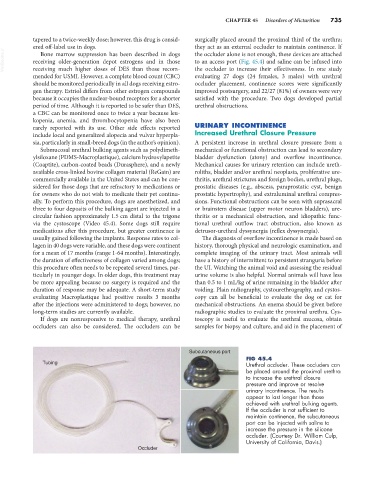Page 763 - Small Animal Internal Medicine, 6th Edition
P. 763
CHAPTER 45 Disorders of Micturition 735
tapered to a twice-weekly dose; however, this drug is consid- surgically placed around the proximal third of the urethra;
ered off-label use in dogs. they act as an external occluder to maintain continence. If
VetBooks.ir receiving older-generation depot estrogens and in those the occluder alone is not enough, these devices are attached
Bone marrow suppression has been described in dogs
to an access port (Fig. 45.4) and saline can be infused into
the occluder to increase their effectiveness. In one study
receiving much higher doses of DES than those recom-
mended for USMI. However, a complete blood count (CBC) evaluating 27 dogs (24 females, 3 males) with urethral
should be monitored periodically in all dogs receiving estro- occluder placement, continence scores were significantly
gen therapy. Estriol differs from other estrogen compounds improved postsurgery, and 22/27 (81%) of owners were very
because it occupies the nuclear-bound receptors for a shorter satisfied with the procedure. Two dogs developed partial
period of time. Although it is reported to be safer than DES, urethral obstructions.
a CBC can be monitored once to twice a year because leu-
kopenia, anemia, and thrombocytopenia have also been
rarely reported with its use. Other side effects reported URINARY INCONTINENCE
include local and generalized alopecia and vulvar hyperpla- Increased Urethral Closure Pressure
sia, particularly in small-breed dogs (in the author’s opinion). A persistent increase in urethral closure pressure from a
Submucosal urethral bulking agents such as polydimeth- mechanical or functional obstruction can lead to secondary
ylsiloxane (PDMS-Macroplastique), calcium hydroxylapetite bladder dysfunction (atony) and overflow incontinence.
(Coaptite), carbon-coated beads (Durasphere), and a newly Mechanical causes for urinary retention can include ureth-
available cross-linked bovine collagen material (ReGain) are roliths, bladder and/or urethral neoplasia, proliferative ure-
commercially available in the United States and can be con- thritis, urethral strictures and foreign bodies, urethral plugs,
sidered for those dogs that are refractory to medications or prostatic diseases (e.g., abscess, paraprostatic cyst, benign
for owners who do not wish to medicate their pet continu- prostatic hypertrophy), and extraluminal urethral compres-
ally. To perform this procedure, dogs are anesthetized, and sions. Functional obstructions can be seen with suprasacral
three to four deposits of the bulking agent are injected in a or brainstem disease (upper motor neuron bladders), ure-
circular fashion approximately 1.5 cm distal to the trigone thritis or a mechanical obstruction, and idiopathic func-
via the cystoscope (Video 45.4). Some dogs still require tional urethral outflow tract obstruction, also known as
medications after this procedure, but greater continence is detrusor-urethral dyssynergia (reflex dyssynergia).
usually gained following the implants. Response rates to col- The diagnosis of overflow incontinence is made based on
lagen in 40 dogs were variable, and these dogs were continent history, thorough physical and neurologic examination, and
for a mean of 17 months (range 1-64 months). Interestingly, complete imaging of the urinary tract. Most animals will
the duration of effectiveness of collagen varied among dogs; have a history of intermittent to persistent stranguria before
this procedure often needs to be repeated several times, par- the UI. Watching the animal void and assessing the residual
ticularly in younger dogs. In older dogs, this treatment may urine volume is also helpful. Normal animals will have less
be more appealing because no surgery is required and the than 0.5 to 1 mL/kg of urine remaining in the bladder after
duration of response may be adequate. A short-term study voiding. Plain radiography, cystourethrography, and cystos-
evaluating Macroplastique had positive results 3 months copy can all be beneficial to evaluate the dog or cat for
after the injections were administered to dogs; however, no mechanical obstructions. An enema should be given before
long-term studies are currently available. radiographic studies to evaluate the proximal urethra. Cys-
If dogs are nonresponsive to medical therapy, urethral toscopy is useful to evaluate the urethral mucosa, obtain
occluders can also be considered. The occluders can be samples for biopsy and culture, and aid in the placement of
Subcutaneous port
FIG 45.4
Tubing Urethral occluder. These occluders can
be placed around the proximal urethra
to increase the urethral closure
pressure and improve or resolve
urinary incontinence. The results
appear to last longer than those
achieved with urethral bulking agents.
If the occluder is not sufficient to
maintain continence, the subcutaneous
port can be injected with saline to
increase the pressure in the silicone
occluder. (Courtesy Dr. William Culp,
University of California, Davis.)
Occluder

